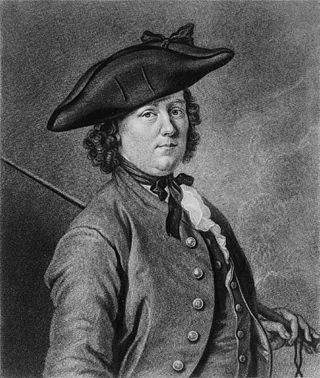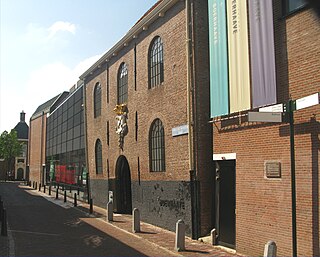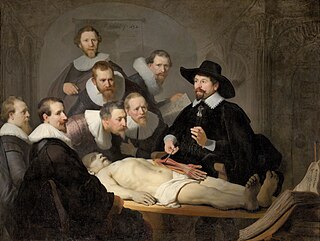Related Research Articles

Andries van Wezel, latinised as Andreas Vesalius, was an anatomist and physician who wrote De Humani Corporis Fabrica Libri Septem, which is considered one of the most influential books on human anatomy and a major advance over the long-dominant work of Galen. Vesalius is often referred to as the founder of modern human anatomy. He was born in Brussels, which was then part of the Habsburg Netherlands. He was a professor at the University of Padua (1537–1542) and later became Imperial physician at the court of Emperor Charles V.

Stegosaurus is a genus of herbivorous, four-legged, armored dinosaur from the Late Jurassic, characterized by the distinctive kite-shaped upright plates along their backs and spikes on their tails. Fossils of the genus have been found in the western United States and in Portugal, where they are found in Kimmeridgian- to Tithonian-aged strata, dating to between 155 and 145 million years ago. Of the species that have been classified in the upper Morrison Formation of the western US, only three are universally recognized: S. stenops, S. ungulatus and S. sulcatus. The remains of over 80 individual animals of this genus have been found. Stegosaurus would have lived alongside dinosaurs such as Apatosaurus, Diplodocus, Camarasaurus and Allosaurus, the latter of which may have preyed on it.

Frederik Ruysch was a Dutch botanist and anatomist. He is known for developing techniques for preserving anatomical specimens, which he used to create dioramas or scenes incorporating human parts. His anatomical preparations included over 2,000 anatomical, pathological, zoological, and botanical specimens, which were preserved by either drying or embalming. Ruysch is also known for his proof of valves in the lymphatic system, the vomeronasal organ in snakes, and arteria centralis oculi. He was the first to describe the disease that is today known as Hirschsprung's disease, as well as several pathological conditions, including intracranial teratoma, enchondromatosis, and Majewski syndrome.

Sarah Baartman, also spelled Sara, sometimes in the diminutive form Saartje, or Saartjie, and Bartman, Bartmann, was a Khoekhoe woman who was exhibited as a freak show attraction in 19th-century Europe under the name Hottentot Venus, a name that was later attributed to at least one other woman similarly exhibited. The women were exhibited for their steatopygic body type uncommon in Western Europe that was perceived as a curiosity at that time, and became subject of scientific interest as well as of erotic projection.

The Wallace Collection is a museum in London occupying Hertford House in Manchester Square, the former townhouse of the Seymour family, Marquesses of Hertford. It is named after Sir Richard Wallace, who built the extensive collection, along with the Marquesses of Hertford, in the 18th and 19th centuries. The collection features fine and decorative arts from the 15th to the 19th centuries with important holdings of French 18th-century paintings, furniture, arms and armour, porcelain and Old Master paintings arranged into 25 galleries. It is open to the public and entry is free.
Feminizing Gender-affirming surgery for transgender women or transfeminine non-binary people describes a variety of surgical procedures that alter the body to provide physical traits more comfortable and affirming to an individual's gender identity and overall functioning.

Body snatching is the illicit removal of corpses from graves, morgues, and other burial sites. Body snatching is distinct from the act of grave robbery as grave robbing does not explicitly involve the removal of the corpse, but rather theft from the burial site itself. The term 'body snatching' most commonly refers to the removal and sale of corpses primarily for the purpose of dissection or anatomy lectures in medical schools. The term was coined primarily in regard to cases in the United Kingdom and United States throughout the 17th, 18th, and 19th centuries. However, there have been cases of body snatching in many countries, with the first recorded case dating back to 1319 in Bologna, Italy.

An anatomical theatre was a specialised building or room, resembling a theatre, used in teaching anatomy at early modern universities. They were typically constructed with a tiered structure surrounding a central table, allowing a larger audience to see the dissection of cadavers more closely than would have been possible in a non-specialized setting.

Many people have engaged in cross-dressing during wartime under various circumstances and for various motives. This has been especially true of women, whether while serving as a soldier in otherwise all-male armies, while protecting themselves or disguising their identity in dangerous circumstances, or for other purposes.

Rijksmuseum Boerhaave is a museum of the history of science and medicine, based in Leiden, Netherlands. The museum hosts a collection of historical scientific instruments from all disciplines, but mainly from medicine, physics, and astronomy.

The Anatomy Lesson of Dr. Nicolaes Tulp is a 1632 oil painting on canvas by Rembrandt housed in the Mauritshuis museum in The Hague, the Netherlands. It was originally created to be displayed by the Surgeons Guild in their meeting room. The painting is regarded as one of Rembrandt's early masterpieces.

Yde Girl is a bog body found in the Stijfveen peat bog near the village of Yde, Netherlands. She was found on 12 May 1897 and was reputedly uncannily well-preserved when discovered, but by the time the body was turned over to the authorities two weeks later, it had been severely damaged and deteriorated. Most of her teeth and hair had been pulled from the skull. The peat-cutting tools had also been reported to have severely damaged the body.

Maria van Antwerpen was a Dutch soldier and seamstress who disguised herself as a man to enlist in the Dutch States Army. She is considered by the Dutch historians Rudolf Dekker and L.J.M. van de Pol as a transsexual woman. Maria married twice to women. Two biographies were published about Maria in her own lifetime, one by Franciscus Lievens Kersteman in 1751.

Elsje Christiaens was a Danish girl who, aged 18, murdered her landlady with an axe in Amsterdam. She confessed and was executed. Her body was exhibited at the Volewijk, a field on the northern shore of the IJ, and Rembrandt van Rijn produced two drawings of it.

Petronella Oortman was a Dutch woman whose elaborate dollhouse is part of the permanent collection of the Rijksmuseum in Amsterdam.
Carolein Smit is a Dutch ceramic art sculptor whose work often includes animals or skeletons.

The Anatomical Machines are a pair of anatomical models reproducing the human circulatory system, displayed in the Cappella Sansevero in Naples. Created in the second half of the 18th century, they are constructed over a male and a female human skeleton. The reproduction of the vessel system is formed of metal wire, wax, and silk, but because of its richness of detail it was for a long time believed to be of natural origin.

SS Willem III was the lead ship of the Willem III class, and the first ship of the Stoomvaart Maatschappij Nederland (SMN). She was burnt on her maiden trip. Later the wreck was repaired and sailed as Quang Se, Glenorchy and Pina.

The Dundee Elephant was an unnamed female Indian elephant, which died on the road between Broughty Ferry and Dundee on 27 April 1706. The elephant was subsequently dissected and described by the Dundee apothecary-surgeon Patrick Blair who published his findings in the Transactions of the Royal Society of London in 1710. This was the first time that a complete elephant had been subjected to scientific anatomical study in Western Europe.

The Barum Woman, formerly known as The Bäckaskog Woman (Bäckaskogskvinnan), is one of the best-preserved skeletal finds in Sweden from the Maglemosian culture of the Mesolithic. She was found in 1939 in Barum and is now in the Swedish History Museum in Stockholm.
References
- 1 2 3 Anna de Haas, "Aal de Dragonder", in: Digitaal Vrouwenlexicon van Nederland , 13 January 2014 (in Dutch)
- ↑ R.M. Dekker and L.C. van de Pol, The Tradition Of Female Transvestism In Early Modern Europe (Basingstoke, 1989), p. 73.